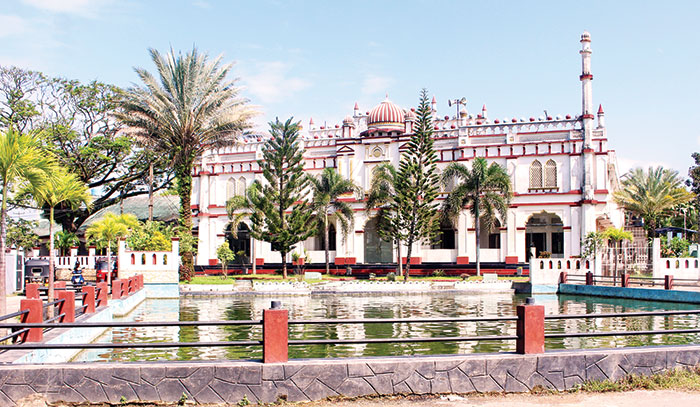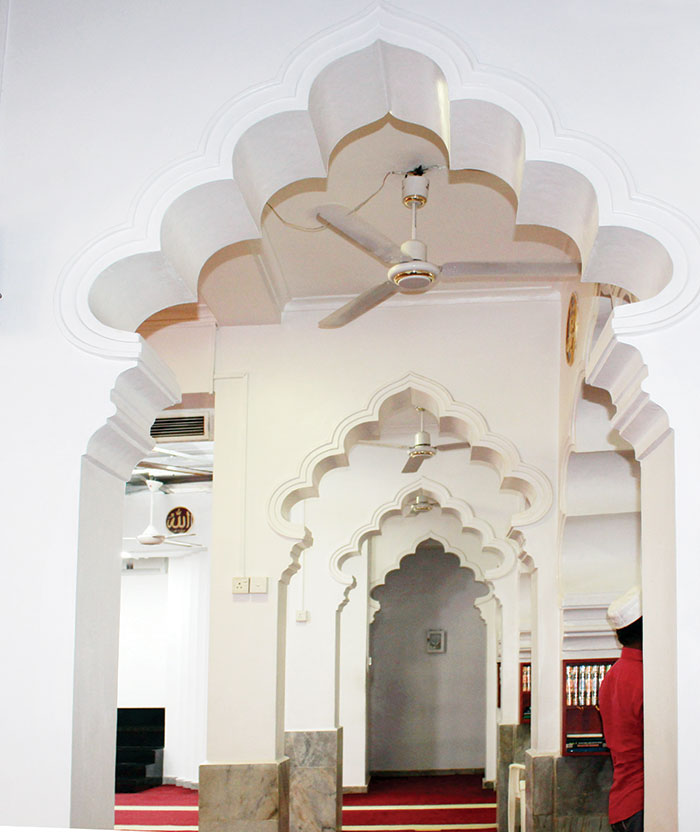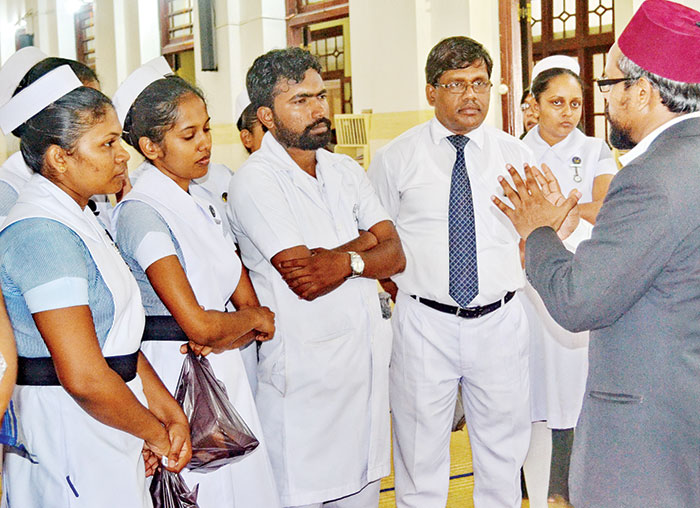
Asiff Hussein, Vice President- Outreach of the Centre for Islamic Studies Harmony Centre and author of the book ‘Iconic Masjids of Ceylon’ speaks about the role of mosques in the Muslim community and the importance of mosque tours in reaching out to people of other faiths.
Q: The Mosque is often thought to be the centre of the Muslim community. How far is this true?
A: The Mosque is no doubt the centre of the Muslim community. It is here that the faithful gather to pray to God, not once, but five times a day. The prayer which is no doubt the most active form of prayer found anywhere in the world consists of cycles of standing, bowing and prostrating before the Almighty. It is from the all important position of prostration known as Sajdah, where one humbles oneself before the Almighty, placing one’s head on to the ground and utterly surrendering oneself to the Divinity that the mosque takes its name. The Arabic word for mosque Masjidis derived from the word Sajdahor ‘Prostration’ and literally means ‘Place of Prostration’.
In the early days of Islam which were its best days, mosques were the very centre of community life. In the time of the Prophet Muhammad (Peace Be Upon Him), the mosque served as an assembly for the community and public announcements were often made there. Women too had free access to the mosque but prayed behind the men. In fact the Prophet clearly prohibited women from being denied entry to the mosques, calling them The handmaidens of God. In a hadith he has stated: “Do not bar the handmaidens of God from God’s Places of Worship”. Sadly this command is observed in the breach today except for festival days when women attend for festival prayers. Cultural norms and ideas of ceremonial impurity of women arising from their monthly periods had a lot to do with this attitude, but fortunately it’s changing and there are mosques today that let women attend and conduct prayers.

Q: You have authored a much acclaimed book on the Mosques of Sri Lanka. Can you share with us some of your more interesting findings?
A: A study of local mosques tells us a lot about how Sri Lankan Muslims adopted the architectural features of neighbouring cultures and in the heyday of colonialism in our island even embraced European styles. In fact, it seems time and place mattered a good deal when it came to mosque architecture. Except for a very basic dedicated area to pray, Islam does not lay down any rigid rules or conventions in erecting a mosque. Thus a mosque can lend itself to a variety of architectural styles. This is why you see such beautiful mosques all over the world having such a great diversity of architectural styles.
In our own country we have the centuries old Bakinigahawela Mosque in Uva Province which appears like the house of a Kandyan nobleman with very thick walls and tiled roof. It has no dome. Similarly there were many mosques in the olden days that had no dome, including the historic Abrar Mosque in the Maradana area of Beruwala supposed to have been built as far back as the year 920. Although it today has a small dome topping its front portion, old photographs show it was clearly absent back then.
In fact the incorporation of a large central dome or domes as we see in many mosques today came only after independence though a few had already adopted it earlier like the onion or pomegranate-shaped domes of the beautiful Red Mosque in Pettah. Nowadays we also have very modern-looking mosques like Jamiah Naleemiah’s University Mosque in Beruwala which has been compared to a flying saucer that has just landed.

Another important outcome of the research was that it proved that Muslims have lived in peace and harmony with the neighbouring communities even when it came to building mosques. I found several instances of co-operation between Muslims and the neighbouring Sinhalese and Tamil communities in putting up mosques back in the good old days. This was seen in the case of Porwa Mosque in Godapitiya in Akuressa and the Jaffna Grand Mosque simply known as the Periyapalli or “Great Mosque’.
Yet another interesting finding that emerged is that Muslims have tended to build their places of worship by the main roads, some of which must have emerged from the old caravan paths which they travelled with their pack animals for purposes of trade in the days of the Kandyan kingdom. Else it was near the bazaars as they were a largely mercantile community. This explains why you find mosques on the sides of roads, some of which look very conspicuous. In contrast you will find that the Buddhists have built their temples amidst calm surroundings away from the hustle and bustle of urban life. This of course reflects the concept of an aramaor ‘retreat’ from the worldly life. This explains why mosques seem so conspicuous when one travels in the main roads while temples are hardly seen.
Q: What can you tell us about the Mosque Tour Programme conducted by your organisation?
A: Mosque Tours are a unique interfaith program conducted by the Centre for Islamic Studies Harmony Center though lately we have partnered with the Muslim Women’s Research and Action Forum in conducting these tours. The mosque tours are undertaken in association with the trustees of local mosques.
Ever since we started the program eight years ago we have seen over fifteen mosques in all parts of the country open its doors to people of other faiths. In fact we have had well over 10,000 visitors of other faiths visiting our mosques on special ‘Open Mosque Days’. The concept I must say is quite revolutionarysince it is the only occasion where any religious place of worship has been opened to the public by special open invitation.
To give you an idea, mosque tours are basically cultural tours which seek to give people of other faiths an opportunity to visit a mosque and through it have a better understanding of the Islamic faith and Muslims in general. It often happens that people of other faiths are keen to visit mosques and experience their rich architecture. There is also thiscuriosity to see what’s going on in mosques. This makes it all the more necessary for mosques to welcome and to be seen as welcoming to those of other faiths.
Q: Besides being seen as a cultural tour, another purpose of mosque tours is to reach out to people of other faiths. So why the mosque for this purpose?
A: A very good question. You see, mosques lend themselves well for teaching people what Islam is all about. The concept of Unitarianism or Oneness of God, the essence of Islamic prayer, the idea of equality of the brotherhood among other things are best explained using the mosque.
For example, the absence of idols explains the concept of Islamic monotheism. The saffor prayer rows marked in the ornate carpets explain the Islamic prayer and the concept of brotherhood where the faithful, whether prince or pauper, stand in prayer shoulder to shoulder before the One True God. The mihrabor prayer niche explains the story of the prophets through that great patriarch Abraham and his building of the House of God in Mecca. The prayer postures demonstrated here explain the meaning of Islamic prayer including Soorah Fatiha, the Opening Chapter of the Holy Qur’an which is likened to the Christian Lord’s Prayer and the Sajdah or Prostrationwhich may be compared to Jesus’ prayer in the Garden of Gethsemane.

Q: Besides a tour of the mosque, what else can visitors expect from your typical mosque tour?
A: Our mosque tours are primarily cultural tours that allow people of other faiths to experience the beauty of Islam and see it in action through a spiritual lens. They are conducting by dedicated Mosque Tour Guide (MTG) in all three languages.
Every mosque tour also has its poster walkthrough where large colourful posters placed side by side form a walkthrough to which visitors are directed shortly after the mosque tour proper. The posters tastefully executed with colourful imagery covers everything from the much misunderstood Shariah Law and Conditions of its Application to Religious Tolerance, Co-existence, Human Rights, Women’s Rights and Animal Rights among other things about which little is known among those of other faiths due to prevailing misconceptions.
Indeed it is often here that visitors began asking questions or concerns they have about the faith, stimulated without doubt by the rich information contained in the posters. To many of our visitors, mosque tours have been the first occasion when they have actually visited an Islamic place of worship and the first experience they have of truly interacting with Muslims and asking anything of them, with absolutely no offence taken. As Muslims we have nothing to hide but much to share.
Besides a tour of the mosque, visitors are given an opportunity to experience the rich culture of the community. They are served traditional Muslim foods, given free calligraphy of their names in beautiful Arabic script as souvenirs to take home and gift packs of literature clearing misconceptions of the Islamic faith.
Mosque Pics Courtesy Asiff Hussein
Post Disclaimer
Disclaimer: THE AMBIENCE OF MOSQUES By Ifham Nizam - Views expressed by writers in this section are their own and do not necessarily reflect Latheefarook.com point-of-view